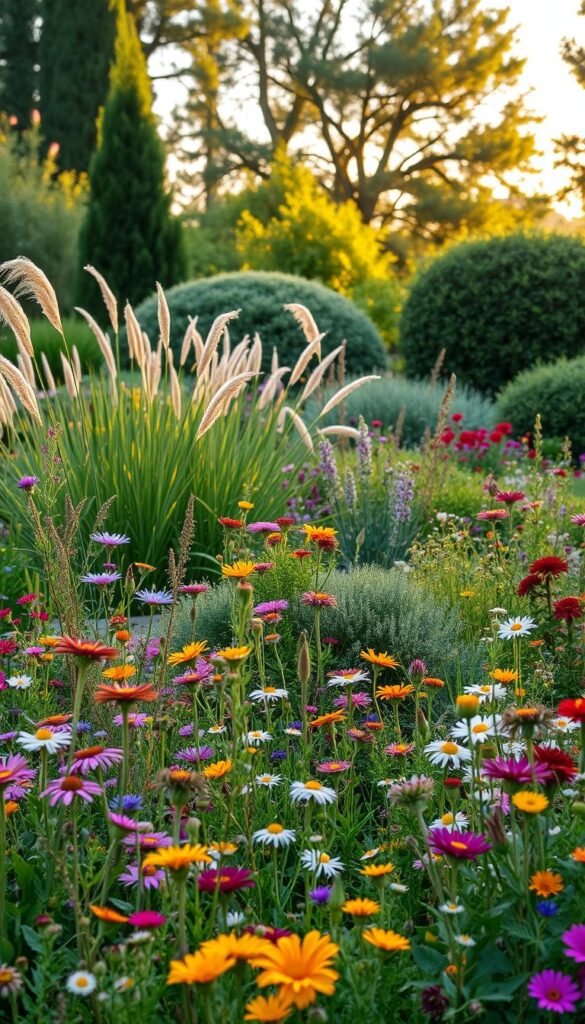Transforming your yard into a vibrant, ever-changing display requires more than just picking pretty blooms. It’s about crafting a living canvas that guides the eye effortlessly while adapting to seasonal shifts. Whether you’re working with a sprawling backyard or maximize small spaces, thoughtful organization makes all the difference.
Great outdoor areas tell stories through their structure. By combining plants of varying sizes and leaf patterns, you create natural pathways that invite exploration. This approach goes beyond basic aesthetics—it’s how professionals build spaces that feel cohesive yet full of surprises.
Seasonal changes become design features when you plan ahead. Early bloomers give way to summer showstoppers, while autumn grasses provide winter texture. The magic happens when these elements work together, creating rhythm that keeps your space engaging year-round.
Our guide reveals how to balance bold statements with subtle details. You’ll learn to position specimens so they complement rather than compete, using growth habits to your advantage. Discover how contrasting forms and surfaces can make even familiar plants feel fresh and exciting.
Understanding the Importance of Visual Flow in Your Garden
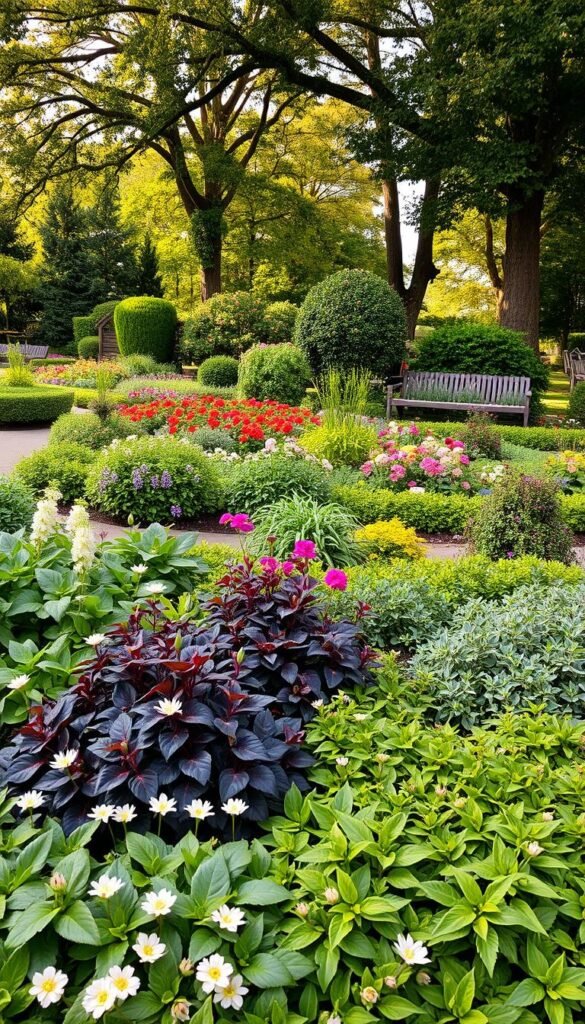
Ever wonder why some outdoor spaces feel effortlessly inviting? The secret lies in visual flow—the subtle art of guiding attention through your space. Like a well-composed song, it carries your gaze from one highlight to the next without abrupt stops.
Why Visual Flow Matters
Random plant placements create visual noise. Professionals group plants in clusters or waves, creating rhythm. This approach turns scattered elements into a unified landscape that feels purposeful.
Think of your yard as a storybook. Each plant grouping acts as a chapter, leading viewers through the narrative. This cohesion makes small areas feel expansive and keeps eyes moving naturally.
The Role of Layering in Garden Appeal
Layering adds depth like brushstrokes on a painting. Tall grasses behind mid-height blooms, with groundcovers at their feet, create year-round visual interest. This technique ensures something always catches the eye, even in winter.
Urban spaces benefit too. Whether working with sprawling yards or urban balconies, layered arrangements maximize impact. They transform flat areas into dynamic living art that changes with seasons.
Done right, your space becomes a destination—not just decoration. Visitors will linger, discovering new details from every angle. That’s the power of thoughtful organization in gardening.
Flower Garden Design Layout for Visual Flow: Layering Heights and Textures
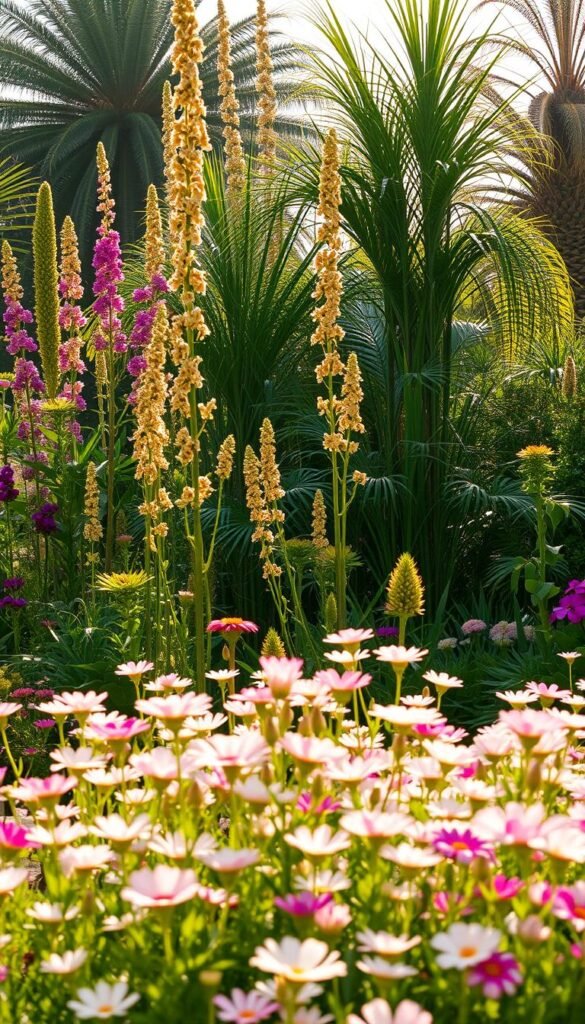
Picture a living tapestry where every element plays its part. That kidney-shaped plot you’ve seen evolve over decades? It started with one apple tree and now thrives through intentional placement. The secret lies in arranging specimens so they enhance each other’s strengths while masking weaknesses.
Start by mapping vertical spaces. Taller specimens like ornamental grasses form nature’s curtain rods, framing your space. Mid-height bloomers become the main actors, while creeping thyme or sedum stitch the scene together below. This three-tiered approach ensures every inch contributes to the overall composition.
Contrast smooth hosta leaves with feathery astilbe plumes. Pair spiky yucca with rounded hydrangea blooms. These combinations create tactile drama that outlasts petal seasons. Evergreen shrubs or seed-bearing perennials keep the show running when flowers fade.
| Layer | Height Range | Texture Examples | Seasonal Role |
|---|---|---|---|
| Canopy | 6-15 ft | Maple bark, pine needles | Year-round structure |
| Understory | 2-5 ft | Peony foliage, iris blades | Spring-summer color bursts |
| Ground | 0-18″ | Moss, creeping phlox | Winter texture anchors |
Successful arrangements consider mature sizes. That cute 12″ salvia seedling? It’ll triple in width by next summer. Leave breathing room between plants to prevent overcrowding while elevating your space through thoughtful spacing.
Rotate seasonal stars through your layers. Early bulbs pop beneath bare branches, summer coneflowers bask in full sun, while autumn sedum heads catch frost crystals. This rhythm keeps your composition fresh without constant replanting.
Assessing Your Garden Space and Environmental Conditions
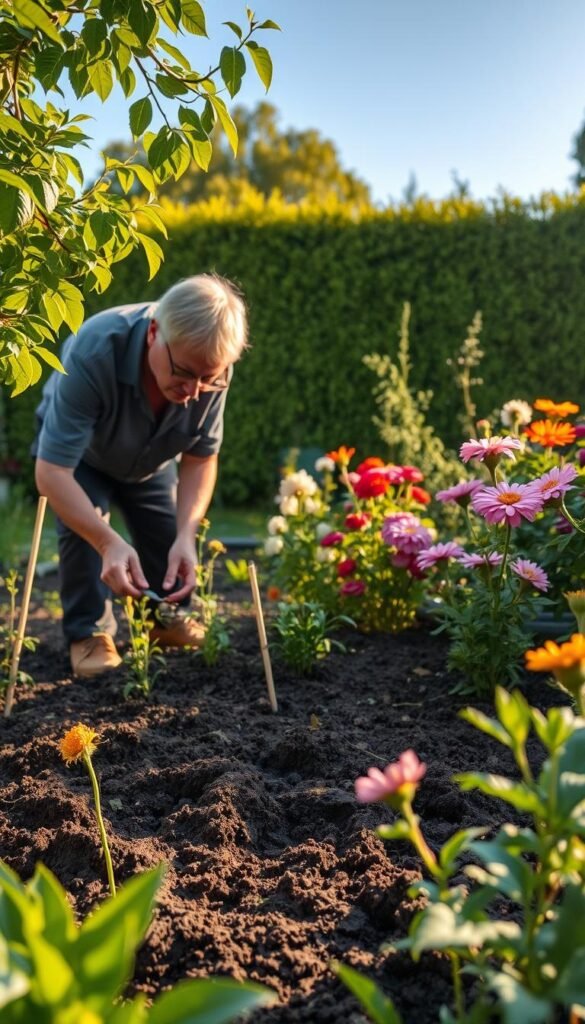
Your outdoor space holds hidden potential—unlocking it starts with understanding its unique personality. Before choosing plants, become a detective. Observe how sunlight dances across your yard and where water pools after storms. These clues shape your strategy for thriving garden beds.
Evaluating Sunlight and Soil Quality
Six hours of daily sun isn’t just a suggestion—it’s survival for most blooms. Track shadows hourly using your phone’s camera. Notice how winter sun angles differ from summer’s peak. Soil health matters equally: dig a 12″ hole, fill it with water. If it drains in under four hours, you’ve got good structure.
Test kits from garden centers reveal pH and nutrient levels. Acidic soil? Add lime. Alkaline? Mix in sulfur. Every April, work fish compost into beds—earthworms will thank you. Come fall, shredded leaves become nature’s mulch blanket, protecting roots while feeding the landscape.
Defining Available Garden Areas
Sketch your space like a treasure map. Mark utility lines, tree roots, and existing features. Measure twice—plants expand faster than you’d think. Sloped areas need erosion control, while low spots suit moisture-loving specimens in pots.
Microclimates create surprises. South-facing walls bake like ovens, while north sides stay chilly. Watch where snow lingers longest—those zones stay wetter in spring. By matching plants to these hidden niches, you’ll make sure every corner of your garden bed thrives naturally.
Exploring Layering: Heights, Textures, and Visual Interest
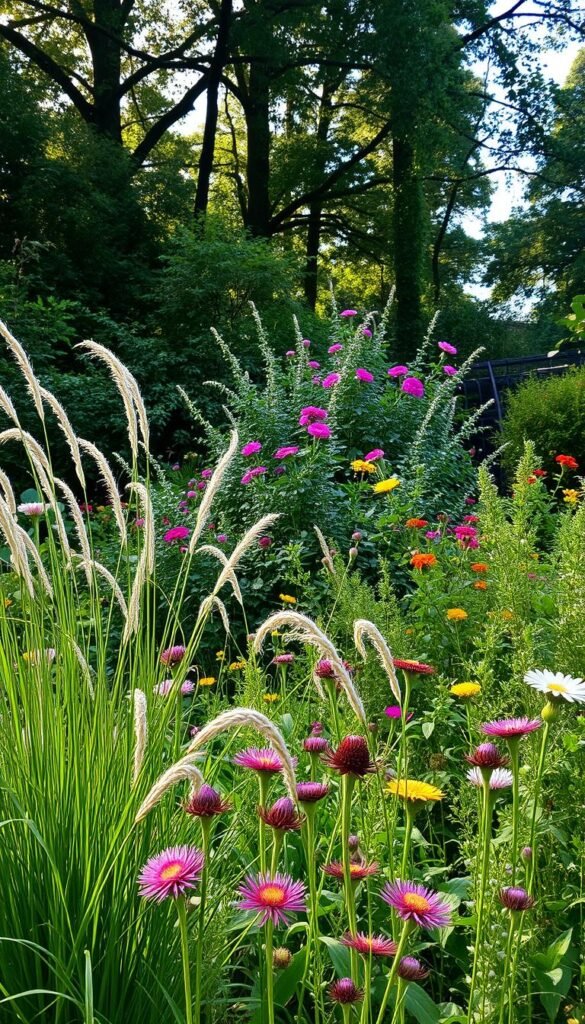
Imagine your outdoor space as a three-dimensional masterpiece where every tier tells part of the story. Strategic arrangement of specimens creates depth that draws people in while keeping maintenance manageable.
Building Vertical Drama
Start with tall anchors like ornamental grasses or ninebark shrubs at the back. These create natural screens while letting shorter neighbors shine. Middle layers work hardest—try spirea’s feathery gold leaves against daylilies’ sword-like foliage. Front borders thrive with creeping sedum or ajuga, their tight forms contrasting with airier plants behind.
Texture: Nature’s Secret Weapon
Combine bold hosta leaves with wispy ornamental grasses for instant drama. Golden feverfew’s lacy blooms add sparkle between broad-leaved heucheras. Remember:
- Pair matte finishes with glossy surfaces
- Mix fine needles (like dianthus) with oversized foliage (bergenia)
- Use seed heads for winter crunch
Space plants using their mature width—not current size. That 1-foot salvia becomes a 3-foot showstopper by July. Leave breathing room so each specimen can strut its stuff without crowding others. Seasonal layers keep the show running: spring bulbs under bare branches, summer coneflowers in full sun, autumn sedums catching frost.
Step-by-Step Guide to Creating a Balanced Garden Layout
Creating harmony in your outdoor space starts with intentional choices. Follow these actionable steps to transform scattered plantings into a polished composition that evolves beautifully through seasons.
Editing and Grouping Your Plants
Begin by removing underperformers. If a plant struggles with diseases, clashes with your color scheme, or demands constant care, it’s time to say goodbye. Focus on reliable varieties that bloom abundantly and require minimal fuss.
Divide established perennials in early spring. One mature hosta can become three new plants—perfect for creating bold clusters. This saves money and ensures you’re working with specimens proven to thrive in your conditions.
Implementing Drifts, Blocks, and Odd Groupings
Professional designers use repetition to build rhythm. Instead of single plants, arrange them in odd-numbered groups:
- Three purple coneflowers form a visual anchor
- Five ornamental grasses create flowing movement
- Seven sedum plants craft a textured carpet
These groupings make your space feel intentional yet natural. For more spatial strategies, explore this guide on how to lay out a garden effectively.
Practical Adjustments Based on Bloom Times
Track which areas look sparse between flowering peaks. If May bursts with tulips but June falters, add daylilies or coreopsis. Shift late-summer bloomers like asters to fill August gaps. This ensures continuous color without overcrowding.
Remember: a balanced layout isn’t static. Rotate plants annually based on performance notes, and let your space mature into its full potential.
Maximizing Color and Seasonal Interest
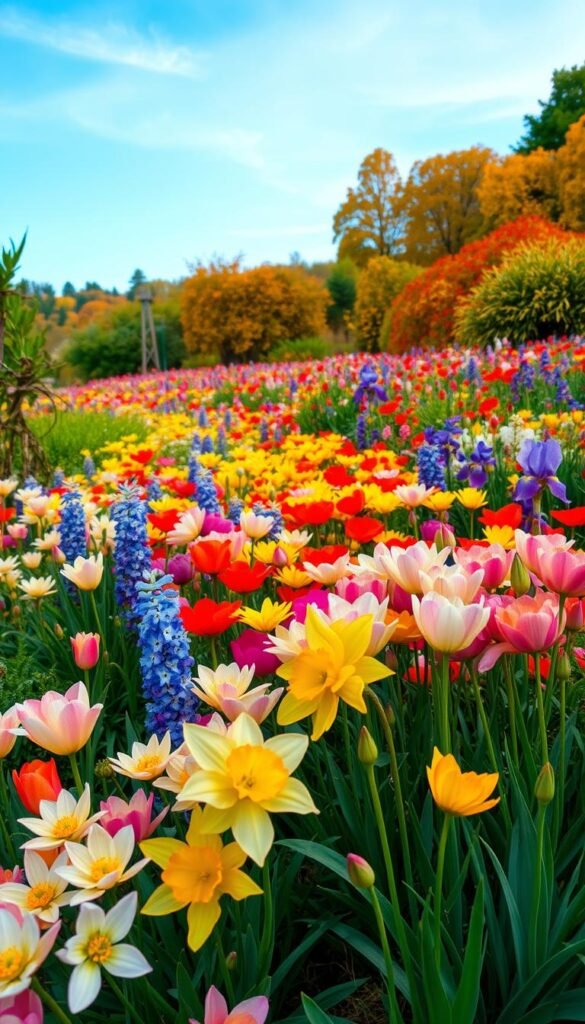
What if your outdoor space could dazzle with shifting colors like a living kaleidoscope? Smart coordination turns ordinary beds into dynamic displays that evolve from spring’s first crocus to winter’s frost-kissed seed heads. The key lies in strategic selection and meticulous tracking.
Curate Your Plant Collection
Limit your palette to 5-7 dominant hues for instant harmony. A restricted selection creates rhythm when repeated through different bloom times. Try pairing purple salvia with yellow coreopsis—their contrasting shades pop while maintaining unity.
Three rules for success:
- Choose multi-season performers like ninebark (spring flowers + winter bark)
- Mix evergreens with deciduous plants for year-round structure
- Document each plant’s peak display period in a gardening journal
Master Seasonal Transitions
Anticipate gaps by tracking what blooms when. Snap weekly photos from the same vantage point—you’ll spot patterns invisible day-to-day. Early tulip beds might need late-blooming asters to bridge summer lulls.
| Season | Color Focus | Texture Boosters |
|---|---|---|
| Spring | Pastels + whites | Emerging fern fronds |
| Summer | Vivid hues | Grass plumes |
| Fall | Warm tones | Seed pods |
Remember: Foliage often outlasts flowers. Burgundy heuchera leaves or blue hostas keep beds lively when blooms fade. As one master gardener notes:
“The best displays happen when you plan for leaves first, petals second.”
Essential Tools and Resources for Garden Planning
Crafting your ideal outdoor space begins with the right tools and trusted advice. Whether you’re sketching your first bed or refining an established area, smart resources streamline the process and boost success rates.
Digital Solutions Meet Hands-On Inspiration
Modern gardening blends technology with tradition. Try free design apps to visualize plant placements or use soil sensors for precise watering. Old-school graph paper still works wonders for mapping sun patterns across your space.
Visit botanical gardens monthly—snap photos of thriving plant pairs in your climate. Pinterest becomes your visual search engine when exploring color schemes. Pro tip: Create boards sorted by season for quick reference.
Wisdom From Those Who’ve Dug Deeper
Local gardeners offer goldmine insights. Join clubs for tours of thriving yards in your area. Online forums reveal which plants outperform in local conditions, saving you trial-and-error time.
Track progress using a journal or photo app. Note which combinations flourish and which falter. As one seasoned grower advises: “Document everything—your future self will thank you when planning next year’s beds.”

